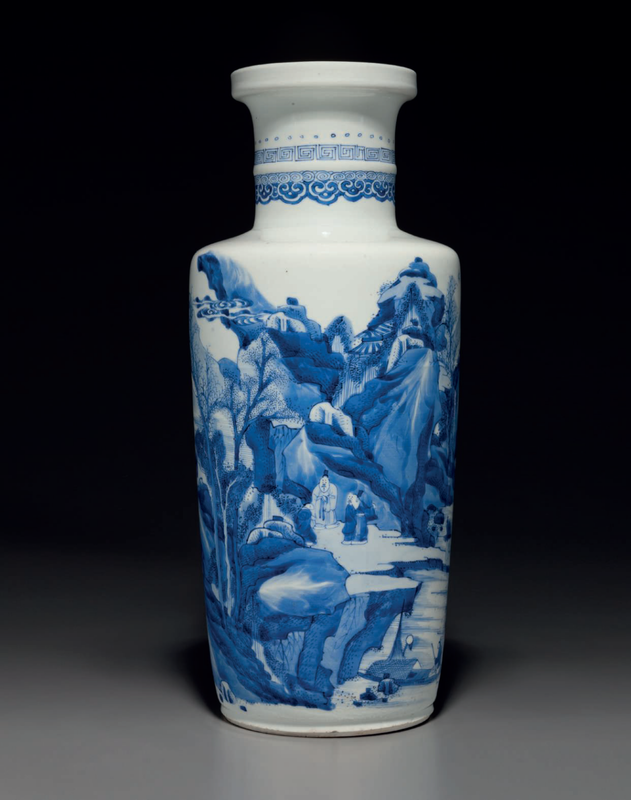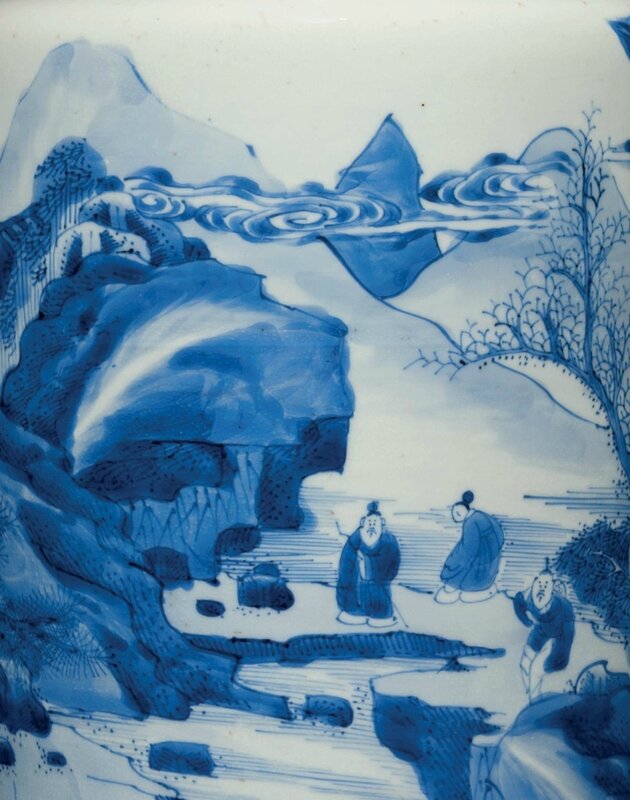A blue and white rouleau vase, Kangxi period (1662-1722)
Lot 738. A blue and white rouleau vase, Kangxi period (1662-1722), 7 1/8 in. (43.5 cm.) high. Estimate USD 50,000 - USD 70,000. © Christie's Images Ltd 2017
The vase is decorated in shades of vibrant underglaze blue with a continuous scene of lone fishermen boating or walking home, and a scholar and attendant on a rocky promontory, all within a mountainous river landscape. The neck is decorated with bands of ruyi, key fret and small dots.
Provenance: Weetman Dickinson Pearson (1856-1927) Collection, 1st Viscount Cowdray.
Weetman Dickinson Pearson was a famous oil industrialist and owner of the Pearson Conglomerate, Liberal MP for Colchester (1895-1910), and a keen philanthropist. In 1909 he purchased Dunecht House, a stately home of elaborate Gothic and Italianate styles to the west of Aberdeen. To expand the residence further, Pearson engaged the services of Ashton Webb, one of the foremost architects of the day whose credits include the principal façade of Buckingham Palace and the main building of the Victoria and Albert Museum. Interior furnishings as imposing as the architecture were required, of which the present vase is a fine example, and it remained at Dunecht for over a century.
Note: Vases such as the present example are justly celebrated for their vivid underglaze-blue painting depicting dramatic mountain landscapes. This style of decoration developed from the 1630s, when the collapse of the Ming dynasty freed the potters of Jingdezhen from imperial influence, and production was instead designed to appeal to the literati class.
One of the foremost developments of this new ‘literati’ style was the continuous landscape in a restricted palette, designed in direct imitation of classical scroll painting. The mountain landscape had long enjoyed particular significance as a religious symbol: it represented the home of the gods; it was a manifestation of qi, the life force, and the source of rain; and as early as the Zhou dynasty, five sacred mountains were designated as holy sites for imperial worship. In the mid-seventeenth century, the mountain also held cultural resonance for the scholar-official, representing an ideal retreat to a peaceful sanctuary away from political turmoil and any unwelcome call to official duties from a new and foreign power.
The success of this innovative style is clear from its continuation into the Kangxi period, when the freshness of the design was complemented by impeccable technique. As Stephen Little notes: "The artistic freedom enjoyed by ceramic decorators at Jingdezhen in these relatively unsettled economic conditions gave way to unsurpassed technical skill once imperial control was re-established at the kilns in 1683, during the early Kangxi reign" (see Julia B. Curtis, Chinese Porcelains of the Seventeenth Century: Landscapes, Scholars’ Motifs and Narratives, New York, 1995, p. 40).
A vase in the Palace Museum, Beijing, with similar decoration of scholars in remote mountains, is illustrated in The Complete Collection of Treasures of the Palace Museum - 36 - Blue and White Porcelain with Underglazed Red (III), Hong Kong, 2000, p. 19, no. 15.
Christie's. Marchant: Nine Decades in Chinese Art, 14 September 2017, New York

/https%3A%2F%2Fprofilepics.canalblog.com%2Fprofilepics%2F1%2F0%2F100183.jpg)
/https%3A%2F%2Fstorage.canalblog.com%2F03%2F02%2F119589%2F96711876_o.jpg)
/https%3A%2F%2Fstorage.canalblog.com%2F11%2F31%2F119589%2F94773502_o.jpg)
/https%3A%2F%2Fstorage.canalblog.com%2F20%2F83%2F119589%2F94772815_o.jpg)
/https%3A%2F%2Fstorage.canalblog.com%2F26%2F72%2F119589%2F75604929_o.jpg)
/https%3A%2F%2Fstorage.canalblog.com%2F59%2F60%2F119589%2F26458628_o.jpg)






/image%2F1371349%2F20240416%2Fob_2a8420_437713933-1652609748842371-16764302136.jpg)
/image%2F1371349%2F20240414%2Fob_83ee65_2024-nyr-22642-0954-000-a-blue-and-whi.jpg)
/image%2F1371349%2F20240414%2Fob_15808c_2024-nyr-22642-0953-000-a-blue-and-whi.jpg)
/image%2F1371349%2F20240414%2Fob_e54295_2024-nyr-22642-0952-000-a-rare-blue-an.jpg)